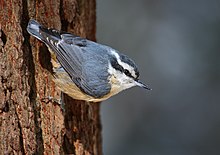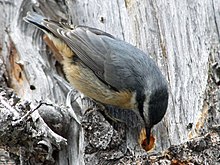Red-breasted nuthatch
| Red-breasted nuthatch | |
|---|---|

| |
| Female in Quebec, Canada | |
| Scientific classification | |
| Domain: | Eukaryota |
| Kingdom: | Animalia |
| Phylum: | Chordata |
| Class: | Aves |
| Order: | Passeriformes |
| Family: | Sittidae |
| Genus: | Sitta |
| Species: | S. canadensis
|
| Binomial name | |
| Sitta canadensis Linnaeus, 1766
| |

| |
| Approximate distribution map
Year-round
Nonbreeding
| |
The red-breasted nuthatch (Sitta canadensis) is a small
Taxonomy
In 1760 the French zoologist
Like all nuthatches, the red-breasted nuthatch is assigned to the genus Sitta (

In the past, the red-breasted nuthatch and four other species — the
Description
The red-breasted nuthatch is a small passerine, measuring 4.5 in (11 cm) in length,[nb 1][12] with a wingspan of 8.5 in (22 cm) and a weight of 9.9 g (0.35 oz).[13] Its back and uppertail are bluish, and its underparts rust-colored. It has a black cap and eye line and a white supercilium (eyebrow). Sexes are similarly plumaged, though females and youngsters have duller heads and paler underparts.[12]
Voice
The red-breasted nuthatch's call is high-pitched, nasal and weak. Transcribed as yenk or ink,[13] they have been likened to a toy tin horn[12] or a child's noisemaker.[14] Its song is a slowly repeated series of clear, nasal, rising notes, transcribed as eeen eeen eeen.[13]
Habitat and range
Though it is primarily a full-time resident of northern and subalpine
Feeding behavior and diet
Like all nuthatches, the red-breasted nuthatch is an acrobatic species, hitching itself up and down tree trunks and branches to look for food.
The red-breasted nuthatch's diet changes depending on the season. In the summer, it eats mostly insects, occasionally even flycatching, while in the winter, it switches to conifer seeds.[18] At feeders it will take sunflower seeds, peanut butter, and suet. It often wedges food pieces in bark crevices in order to break them up with the bill (as opposed to holding the food in their feet, like the black-capped chickadee does).
Breeding
The red-breasted nuthatch, like all nuthatches, is monogamous. The male courts the female with a peculiar display, lifting his head and tail while turning his back to her, drooping his wings, and swaying from side to side.
This bird excavates its own cavity nest, 1.53–37 m (5.0–121.4 ft) above ground (usually around 4.6 m (15 ft)). Excavation is by both sexes and takes one to eight weeks.[19] The pair smears sap around the entrance hole, presumably to help deter predators.[17] The nest is lined with grass, moss, shredded bark and rootlets. Nest building is by both sexes, but mostly by the female.
The female lays 2–8
Conservation status and threats
Because of its large global range and its increasing population, the red-breasted nuthatch is rated as a species of
Notes
References
- ^ a b BirdLife International (2012). "Sitta canadensis". IUCN Red List of Threatened Species. 2012. Retrieved 26 November 2013.
- ^ Brisson, Mathurin Jacques (1760). Ornithologie, ou, Méthode contenant la division des oiseaux en ordres, sections, genres, especes & leurs variétés (in French and Latin). Vol. 3. Paris: Jean-Baptiste Bauche. pp. 592–594, Plate 29 fig 4. The two stars (**) at the start of the section indicates that Brisson based his description on the examination of a specimen.
- ^ hdl:2246/678.
- ^ Linnaeus, Carl (1766). Systema naturae : per regna tria natura, secundum classes, ordines, genera, species, cum characteribus, differentiis, synonymis, locis (in Latin). Vol. 1, Part 1 (12th ed.). Holmiae (Stockholm): Laurentii Salvii. p. 177.
- ^ Linnaeus, C (1758). Systema naturae per regna tria naturae, secundum classes, ordines, genera, species, cum characteribus, differentiis, synonymis, locis. Tomus I. Editio decima, reformata (in Latin). Holmiae. (Laurentii Salvii). p. 115.
Rostrum subcultrato-conicum, rectum, porrectum: integerrimum, mandíbula superiore obtusiuscula. Lingua lacero-emarginata
- ^ ISBN 0-88192-600-0.
- ^ "Nuthatch". Merriam-Webster Online Dictionary. Merriam-Webster Online. Retrieved 10 May 2011.
- ^ Elphick, Dunning and Sibley 2001, p. 435
- ^ a b Harrap 2008, p. 136
- .
- ISBN 0-19-857358-8.
- ^ ISBN 0-7922-5314-0.
- ^ ISBN 1-873403-98-4.
- ISBN 978-0-9640810-7-9.
- ^ ISBN 978-0-19-854012-0.
- ISBN 978-0-9542545-3-7.
- ^ a b Reed 2001, p. 437
- ^ Harrap, Simon; Quinn, David (1996). Tits, Nuthatches & Treecreepers. London: Christopher Helm. pp. 144–148.
- ^ Reed 2001, p. 436
- ^ "All About Birds: Red-breasted Nuthatch, Life History". Cornell Laboratory of Ornithology. Retrieved 26 May 2011.
- US Fish and Wildlife Service. Retrieved 16 September 2011.
Cited texts
- Reed, J. Michael (2001). "Nuthatches". In Elphick, Chris; Dunning Jr., John B.; Sibley, David (eds.). The Sibley Guide to Bird Life & Behaviour. London: Christopher Helm. ISBN 0-7136-6250-6.
- Harrap, Simon (2008). "Family Sittidae (Nuthatches)". In del Hoyo, Josep; Elliott, Andrew; Christie, David (eds.). Handbook of Birds of the World, Volume 13: Penduline-tits to Shrikes. Barcelona: Lynx Edicions. ISBN 978-84-96553-45-3.
External links
- Red-Breasted Nuthatch - Sitta canadensis - USGS Patuxent Bird Identification InfoCenter
- "Red-breasted Nuthatch media". Internet Bird Collection.
- Red-breasted Nuthatch, Hinterland Who's Who
- Red-breasted Nuthatch photo gallery at VIREO (Drexel University)
- Interactive range map of Sitta canadensis at IUCN Red List maps


